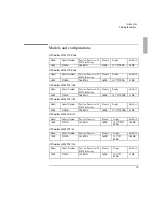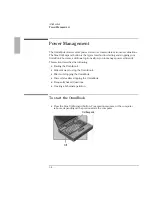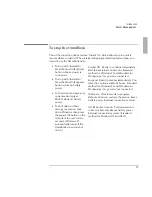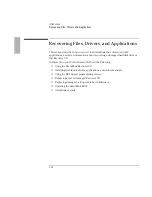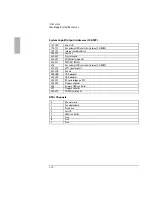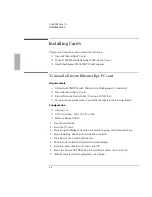
Introduction
Identifying System Resources
1-19
Identifying System Resources
These default values offer maximum utility for most users; however, alternate
configurations exist in the System Configuration Utility, which lists port and audio
device configurations in the Input/Output menu. The tables in this section show
initial resource usage. Plug-and-play operating systems, drivers, and the SCU may
change some entries.
Note
See the
Installation and Setup Guide
for more information about using the System
Configuration Utility (SCU)>
System Interrupts
0
System timer
1
Keyboard
2
Redirect IRQ 9
3
COM2 and COM4 (undocked) / Free (docked)
4
COM1 and COM3 (serial port)
5
Crystal sound
6
Disk drive
7
LPT1 (parallel port)
8
Real-time clock
9
MIDI
10
PCI-type interrupt: CardBus, and SCSI (docked)
11
Free
12
Mouse
13
Coprocessor
14
Internal hard disk drive(primary IDE controller)
15
Internal CD-ROM (secondary IDE controller)
System Memory
C0000 -CAFFF
Chips & Technologies video BIOS
CB000 -CBFFF
Enhanced parallel port BIOS
CC000 -E7FFF
Free (see below)
E8000 -FFFFF
Plug-and play, PCI, and system BIOS
Valid uses for memory addresses CC000-E7FFF:
•
Upper memory blocks (UMBs) in the range CC000-E7FFF.
•
PC card and ISA/PCI card memory windows in the range CC000-DFFFF.
•
ISA/PCI card boot ROM in the range CE000-DFFFF.
Summary of Contents for OMNIBOOK 5700
Page 1: ...HP OmniBook 2000 5700 Corporate Evaluator s Guide ...
Page 9: ...1 Introduction ...
Page 30: ......
Page 31: ...2 Using Windows 3 x ...
Page 45: ...3 Using Windows 95 ...
Page 67: ...4 Using Windows NT 3 51 ...
Page 81: ...5 Using Windows NT 4 0 ...
Page 99: ...6 Using OS 2 Warp 4 0 ...
Page 116: ......
Page 117: ...7 Using the OmniBook Docking System ...
Page 124: ......
Page 125: ...8 Features and Support Services ...

